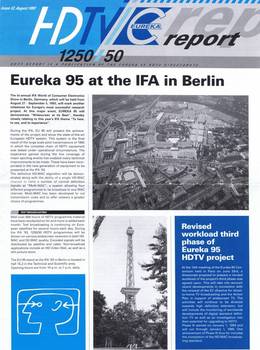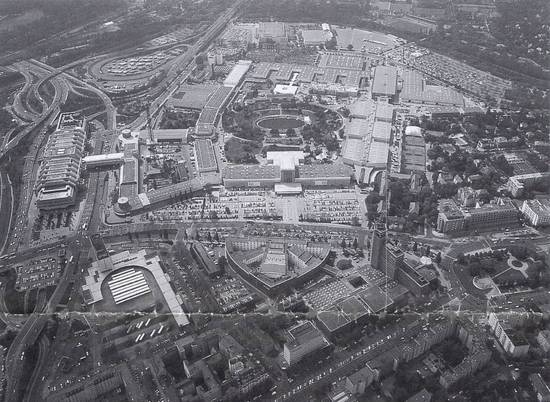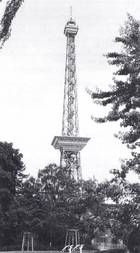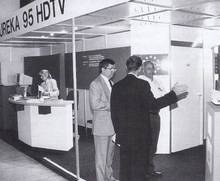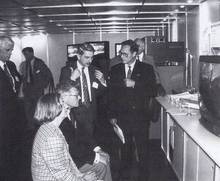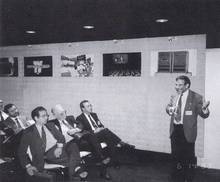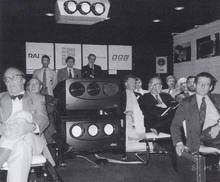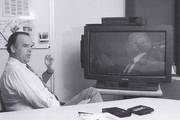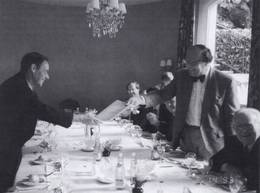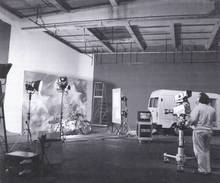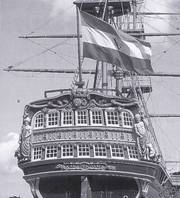Der Eureka Report - issue 12 - Aug. 1993
Es ist der letzte uns vorliegende (und vermutlich der allerletzte) Eureka 95 Report. Danach wurde es ruhiger und vermutlich gingen so langsam die Lichter aus. Die "Partner" oder die "participians" konnten sich doch nicht einigen, gehts jetzt los oder nicht. Aus den uns vorliegenden Zeitungsausschnitten ersieht man, daß immer wieder irgend einer der Entscheider aufstand und erhebliche Zweifel am Sinn des Ganzen entfachte. Es war auch den technisch weniger versierten Intendanten bewußt geworden, daß sich da im digitalen Bereich "etwas" tat, das weitaus schneller rannte, als den vermeintlich schnellen Europäern lieb war.
Auf der anderen Seite wollte keiner (kein Politiker und keiner aus dem Direktorium) eingestehen, daß da Millionen aus dem Fenster "geschnipselt" worden waren, weil keiner zur rechten Zeit das Signal auf rot gestellt hatte oder stellen konnte (oder durfte). Das Geld war ja nicht wirklich versenkt oder verbrannt worden, fast jeder hatte doch einige wirklich wertvolle und tiefgreifende Erkenntnisse gewonnen und nicht nur technische Erkenntnisse. Und wenn es nur die Einschätzung der EU Regierungen untereinander und deren Interessen und deren Verläßlichkeit war. Auch bei den konkurrierenden Firmen kristallisierten sich die nationalen und lokalen Eigeninteressen heraus. Die Franzosen wollten ihre Thomson Kameras und ihre Angenieux Zoom-Optiken europaweit quasi per Gesetz oder per Norm durchdrücken oder aufzwingen. Das gefiel den Holländern natürlich ganz und gar nicht. Die Deutschen aus Darmstadt waren stinkig auf die eigenen Kollegen aus Holland, weil man sie mit den technologisch veralteten Plumbicon Röhren hatte zumindest schlitzohrig auflaufen lassen. Und eigentlich hatten sie ja in Darmstadt auf riesen Umsätze mit den beiden Herzstücken, dem HDTV Mischer und der HDTV MAZ gerechnet, ohne die bei HDTV sowieso nirgendwo etwas lief. Auch der Beamer-Hersteller hatte sich etwas von dem goldenene Kuchen versprochen und nicht nur der.
.
Eureka 95 at the IFA in Berlin
The bi-annual IFA 1993 "World of Consumer Electronics Show" in Berlin, Germany, which will be held from August 27. - September 5. 1993, will mark another milestone for Europe's most successful research project. At this major event, EUREKA 95 will demonstrate "Widescreen at its Best", thereby closely relating to this year's IFA theme "To hear, to see, and to experience".
During the IFA, EU 95 will present the achievements of the project and show the state-of-the-art European HDTV system. This system is the final result of the large scale pilot transmissions of 1992 in which the complete chain of HDTV equipment was tested under operational circumstances. The experience gained during the live coverage of major sporting events has enabled many technical improvements to be made. These have been incorporated in the new generation of equipment to be presented at the IFA '93.
The definitive HD-MAC algorithm will be demonstrated along with the ability of a single HD-MAC channel to carry a number of normal definition signals as "Multi-MAC", a system allowing four different programmes to be broadcast in one MAC channel. Multi-MAC has been developed to cut transmission costs and to offer viewers a greater choice of programmes.
TEST BROADCASTING in Berlin
Well over 600 hours of HDTV programme material have been stockpiled so far and more is added each month. Test broadcasting is continuing on European satellites for several hours each day. During the IFA '93, 1250/50 HDTV programmes will be shown on various widescreen receivers in both HD-MAC and D2-MAC quality. Encoded signals will be distributed by satellite and cable. Non-broadcast applications include an HD Video Wall, as well as a still picture store.
The EU 95 stand at the IFA '93 in Berlin is located in hall 15.2 in the Technical and Scientific area. Opening hours are from 10 a.m. to 7 p.m. daily.
Revised workload third phase of Eureka 95 HDTV project
At the 14th meeting of the Eureka 95 Consortium held in Paris on June 23rd, a directorate proposal to prepare a revised workload of the project's third phase was agreed upon. This will take into account recent developments in connection with the renewal of the EC directive for direct-to-home TV broadcasting and the Action Plan in support of widescreen TV. The activities will continue to be directed towards high definition television, but will include the monitoring of worldwide developments of digital standard definition TV as well as an investigation into their potential for upgrading to HDTV. Phase III started on January 1, 1993 and will run through January 1, 1995. One achievement of Phase III thus far includes the completion of the HD-MAC broadcasting standard.
Accelerate market developments, says European Council
The Council of the European Communities recently agreed to spend ECU 228m of the EC budget over the next four years promoting widescreen television services in Europe. Telecommunications ministers issued a resolution stating the necessity to accelerate the market developments necessary for the introduction of Advanced Television Services in the widescreen 16:9 format in Europe. An Action Plan will result in the implementation of high definition television in Europe. This plan, however, is not tied to a particular technology. The Council emphasizes the need to expand the scope to allow other standards, in addition to D2-MAC, to be used for the broadcast of widescreen television programmes.
COHERENT GLOBAL APPROACH
In earlier resolutions, the EC already recognized the importance of HDTV for the European consumer electronics and the television and film industries, and established a framework for the introduction of European HDTV.
However, digital technology will be important for future television systems and the EC is convinced that Europe must have a coherent global approach to the development of technology and standards for new digital television systems.
The earlier EC directive will therefore be revised by October 1, 1993 and take into account standards for both terrestrial transmission and cable distribution, the need to limit the number of different standards, and standardized encryption systems in Europe.
The action plan is solely directed at promoting the 16:9 format - 625 or 1250 lines - and not tied to a standard or broadcasting mode. The funds will be made available yearly on a first-come, first-serve basis to broadcasters and programme makers in order to help them upgrade equipment, convert existing programmes into the wide-screen format, and produce new programmes.
Funds will only be released if industry or public institutions come up with matching investment. The support will depend on the actual costs of the type of programme and its technical quality, with special emphasis on programmes produced in Europe. New productions will receive the highest level of support. And only broadcasters transmitting more than 50 hours of 16:9 services per year will receive funding.
18th International TV Symposium and Technical Exhibition - Montreux
"Widescreen TV at its Best" - a proven fact
EUREKA 95's theme for this year's presentation at the International TV Symposium and Technical Exhibition in Montreux, ''Widescreen at its Best", turned out not to be just a slogan but a proven fact instead. Visitors to the EUREKA 95 stand in the "Pavilion for Future Technology" could witness daily HD-MAC transmissions of programmes that were specially produced for the occasion and broadcast via three different satellites: TVSat (Germany), Telecom (France), and Olympus (Italy).
The encoder and decoders used were of the so-called "post Olympic" type, meaning that they incorporated the improvements in the HD-MAC algorithm which were implemented after the extensive pilot tests of the system during the Olympic Games in 1992. The results could be seen at several places in the stand, for instance in the theatre, where the pictures were projected on a large screen via - alternately used - Barco and Seleco frontprojectors. In addition, the decoded HD-MAC signals were shown in the open part of the stand on Barco monitors. The compatible picture could be seen on D2-MAC sets which are currently being sold on the market by Nokia, Thomson, and Philips.
UNANIMOUS ADMIRATION
At regular intervals the audience in the theatre was invited to listen to a brief history of the EUREKA 95 project, including the remarkable world's firsts it has scored. This presentation was followed by a ten-minute screening of an HD-MAC transmission from satellite and another six minutes of a special BBC compilation encoded in HD-MAC and replayed from a D1 Video Tape Recorder. The BBC production included a selection of surround sound sequences. The visitors were unanimous in their admiration and enthusiasm for the excellent quality of the pictures.
The two new FIMI studio monitors located at the entrance of the stand drew many interested visitors. One displayed pictures from a still picture store, while on the other one HDTV pictures were shown. Another novelty was the presentation of Multi-MAC, a delivery system allowing for four different programmes to be transmitted in one MAC channel. The complete picture could be seen on a rear projector, while four D2-MAC sets each displayed one of the quadrants of the rear projector.
TELEPRESENCE
A good example of a non-broadcast application was the third generation HD-LaserDisc player, which replayed parts of a training programme made for train drivers of the Dutch railways. Many a visitor sat down to get the feeling of "telepresence" brought about by the widescreen effect and the accompanying sound of the onrushing train.
At the request of the European Broadcasting Union the tapes used for testing the HD-MAC system were shown a number of times to an invited audience. It was during one of these screenings that the realization sunk in that the viewing distance from the first row of chairs was only once the height of the screen instead of three times. Yet the picture showed no perceptible artefacts, thus illustrating and underscoring the verdict of the EBU tests: in most cases there is no difference between HD-MAC and the original source material.
EC subsidy boosts TV Plus' ambitions
The drive at TV Plus to explore widescreen and HDTV production seems stronger than ever. The announcement that an extra EC grant has been awarded to the first regular widescreen TV channel couldn't have come at a better time: the news broke while an HDTV programmemakers seminar was in full swing and was received with great joy and appreciation.
Meanwhile, the final word has not been spoken on the method of transporting widescreen and HDTV signals, after the industry reached agreement on a digital transmission standard in the USA.
"But there's a lot more to broadcasting than transmitting the signal", says Cees Dorland, TV Plus' managing director. "I am still not convinced that it has been wise to drop a perfect system that is fully operational in favour of a digital standard that isn't. It's rather like being set back by about four years. But apart from that, our mission at TV Plus is putting widescreen and HDTV into practice. It is relevant to us that we maintain an aspect ratio of 16:9. And in the case of HD productions, we obviously care about the picture definition, too. Whatever conversion or transmission technology is used to get our product on the screen, it doesn't change one item of our production standard, which withstands any quality competition - it is simply perfect, and our HDTV tapes are suitable for future use as a master for any standard, even 35mm Cinemascope."
FAMILIARIZING WITH 16:9 AND HD
The crystal-clear task assigned to TV Plus was, and still is: to introduce widescreen TV and learn how to operate it professionally. The partners participating in TV Plus - Dorland refers to them as "my four bosses" - are Philips Nederland, PTT Telecom, the Netherlands Broadcasting Corporation (NOS) and the Netherlands Broadcasting Services Corporation (NOB).
All four have a specific interest in familiarizing themselves with 16:9 and HD television, and with the features it will offer. Along with the spectacular improvement of screen size, TV Plus is putting EuroCrypt and Smart Card applications into practice, in preparation of high-tech Pay TV, while production people are developing their expertise by studying the differences in camera movement, stereo sound and set design. TV Plus is getting European TV production ready for its widescreen future. And these are just a few examples of how they are doing it...
WORLDWIDE STANDARD
Cees Dorland: "It's not at all as if we are practising a skill that may become obsolete. Nobody has any doubts that 16:9 will become the worldwide standard - and those are exactly the kind of programmes we are making. It is the process that follows our production and post-production phase that is being changed. As soon as that part is ready, the broadcasting specifications for HDTV will be very different indeed. That doesn't diminish the importance of our widescreen and HD production experiments. Our HDTV video tapes have been produced according to the highest standards and can be used as master tapes for any purpose - by PAL or NTSC stations in the short term or via any other transmission system in the somewhat more distant future. And let's not forget non-broadcasting applications. Organizations with which we make co-productions are already showing widescreen productions at a number of events. The impact on the viewer makes widescreen the perfect promotional tool."
EXTRA SUBSIDY MEANS EXTRA SCREEN TIME
The ambitions of Europe's first widescreen TV station seem far from dented. Its managing director had already decided to produce no less than 200 hours of 1250/50 HD programmes in 1994 - an enormous increase compared with this season's 40 hours. As soon as part of the recent 228 million ECU subsidy starts making its way towards TV Plus, Dorland intends to concentrate on 625/50 widescreen field production and produce many more widescreen hours than the 200 he aimed at until recently.
"The 625/50 programming will include sporting events, light entertainment and other subjects that probably won't have to be repeated in future, contrary to our cultural and historic HDTV productions that have an 'eternal quality'... The LDK 91 16:9 widescreen camera by BTS even enables us to try out widescreen ENG production."
In other words: the EC subsidy can boost wide-screen and HDTV production, while a digital transmission standard will not stand in TV Plus' way. Cees Dorland: "My greatest concern is the pace of development. It would be silly to wait years and years for a digital standard, when we have a fully operational standard we can work with right now. Our experience of today will be very valuable in the future 'HDTV age'.
To only wait and see doesn't give us any experience at all." "TV Plus' longterm objectives don't always harmonize with the day-to-day objectives of my 'bosses', that's another aspect. I understand perfectly well that some partners tend to slow down in a recession or prefer to wait and see what the digital standard will bring us. At this moment the broadcasting organizations are taking their time, thinking 'We still have years to go, why should we go any faster than the industry with all its commercial interests?' — and of course they are right if it is the availability of equipment they're referring to. This project will not be fully matured until high-definition receivers and decoders are made available to the consumer."
TV Plus's Managing director Cees Dorland: "Ultimately, the broadcasting specifications for HDTV will be different That doesn't diminish the importance of our widescreen production experiments, however."
Eureka pleased with Grand Alliance
EUREKA 95 participants have reacted positively on the digital HDTV proposal that was recently submitted to the FCC Advisory Committee. "There is an enormous pressure on the FCC to decide on a single HDTV standard before the end of 1993. The development of a digital transmission system is in its infancy. The only way to come to a successful system is to combine the expertise of all bodies involved in the Grand Alliance", says Piet Bogels, president of the EUREKA HDTV Directorate.
Even though the FCC is attempting to decide on a standard before the end of this year and a timeline has been set for testing and reviewing the proposal, it is expected that it may take longer before a final standard is agreed upon. It goes without saying that the industry will benefit from a fast decision. Within the Grand Alliance, the partners have agreed on the division of revenues.
There is more space available in the American transmission network than there is in Europe. What's more, frequencies have been set aside particularly for a digital system. The final system in the U.S. will most likely be a non-scalable 6 Megahertz system for terrestrial HDTV. It is the FCC's intention to switch over to the new standard in 2008, at which time the current NTSC system will cease to exist.
Cooperations such as the Grand Alliance are not new in Europe. Europe has a long history of partnerships and joint ventures for the development and introduction of new standards, systems, and products. It is virtually impossible for one industry to singlehandedly introduce a standard that is accepted by a country, a continent or let alone by the world. And what's more, the industry needs access to the patents and know-how of research laboratories. Research laboratories, on the other hand, spend all their funds and efforts on R&D while running the risk that their developments flop and no income can be derived from them. An alliance offers a better chance of success.
FIRM BELIEVER
Pieter Boegels is a firm believer that Europe can also benefit from the Grand Alliance. "In the U.S., there is a great amount of know-how with regards to digital technology, the integration of digital processing. The chips for portable computers are an excellent example. These chips are really building blocks that together are the foundation for innumerable applications in consumer electronics, telecommunications, and more. If we don't go along in this development, Europe will loose out. On the other hand, we posses extensive know-how in the field of signal processing and systems. The U.S. needs this knowledge as much as we need theirs. I can see an increasing, fruitful collaboration in the years to come."
Would a worldwide Grand Alliance be possible? In Europe, Thomson and Philips are already extensively working together. The knowledge of the industry, not just within Europe, but also in Japan and the U.S. is increasingly becoming common property. MPEG, the Motion Picture Experts Groups, is a good example. Within this group, Japanese, American and European companies are jointly working on the compression of video signals and developing the required integrated circuits. These ICs, in turn, may be used as a building block in (differing) HDTV systems all over the world.
Another example is the development of digital VCRs (see article elsewhere in this issue). Digital VCRs make use of a limited bandwidth. By modulating the channels, the compression system for video signals that is being developed right now could be adapted for use in digital VCRs, LaserDisc players, and for terrestrial, satellite or cable transmissions as well. It is possible to make the compression system completely transparent, so that recoding becomes redundant. However, such a development can only take place on one condition: all players have to agree!
DIGITAL TRANSMISSION IN EUROPE
Europe has made clear that it is not yet willing to accept the HD-MAC transmission standard. At the same time, technological developments continue to take place. EUREKA 95 will therefore carefully study the digital transmission technology. The first focus of attention will be on compressing the video signal, followed by the digital transport of the signal and increasing the bandwidth. As Pieter Boegels puts it: "We are only at the beginning of the learning curve. EUREKA 95 has proven that we can work together and be successful in the development of an HDTV system. In addition to the transmission standard we can do more, much more."
FCC will consider HDTV Grand Alliance proposal
The U.S. Federal Communications' Advisory Committee on Advanced Television Services is reviewing a single digital HDTV system proposed by the "Grand Alliance" of entities that had earlier worked on the development of competitive HDTV systems. The merged system proposal of AT&T, the David Sarnoff Research Center, General Instruments, MIT, Philips, Thomson, and Zenith is the result of a business and technical agreement between the partners. If adopted, the proposed all-digital system, which would facilitate interoperability among broadcasting, cable, computer, and telecommunications technologies, could place the US in the forefront of high definition video technology.
Important aspects of the Grand Alliance proposal include the use of progressive scan transmission, where entire picture frames are transmitted sequentially, and the use of so-called "square pixels", where the dots on a television screen are arranged in equally spaced rows and columns. Both of these design aspects are important for the interoperability of HDTV with computers, telecommunications, and other media.
The Grand Alliance partners unanimously endorse a higher line number (more than thousand) and will work together to eliminate interlaced scanning format from the transmission path in the future. To support multiple transmission formats, the merged system will feature source adaptive processing. A prioritized, packaged data transport structure will guarantee system flexibility and extensibility.
Based on the results of the current testing, the Advisory Committee may recommend the system to the FCC as the basis for an HDTV standard for the United States.
Polygone sets trend with HDTV facilities
The Brussels-based recording and post-production company Polygone S.C. has become the first private enterprise in the Benelux to own an HDTV mobile reporting unit fitted with BTS equipment, supplied by Philips and boasting an LDK 9000 HDTV CCD camera, a BCH 1000 HDTV video recorder and peripheral equipment. Polygone offers these facilities to the advertising, broadcasting and non-broadcasting sectors. Expert staff, if required, can also be supplied.
Before taking delivery of the OB Van, Polygone had already acquired considerable experience with HDTV facilities, producing among other things 'La Voix de Cristal', a documentary on the traditional manufacture of crystal objects. In addition to documentaries, Polygone will also use the HDTV mobile reporting unit for its two main activities: recording and post-production services for producers of TV and cinema commercials.
GRAIN
Claude Haim, managing director of Polygone, confirms that the 'grain' which is so characteristic of the well-known film images provides something of a magical element: "HDTV offers an improved representation of reality. After all, HD video is the current superior standard. However, film also stands for imagination, which is why directors and producers often attach greater value to the grain than you might think."
Polygone's solution to this dilemma is both simple and effective: recording, editing, special effects and colour correction are all done in HDTV. The end result is transferred to 35 mm film at the very end of the route, when the master tape is completely finished - an ideal production method preserving the grain that is so greatly appreciated when films are shown on screen.
Claude Haim explains: "The image and sound of HDTV are extremely detailed and colour corrections can be made much more easily and accurately, but that is not the only reason why producing in HDTV is ideal: it is also an extremely practicable production method, which allows you to analyze the visual result at any stage during the process. You don't have to rely on laboratories any longer. But in the end, the overwhelming argument for many of our customers will be that HDTV quickly proves to be the most cost-effective option."
EFFICIENCY
Claude Haim: "We save money on pricy film material and laboratories while investing an equivalent amount in our own HDTV facilities. HD video has thus given us access to all these processes in-house, while achieving a better result and improving efficiency. The more paid HD hours I have, the more cost-effective the whole process becomes -but even at fifty shooting days per year, we manage to beat the costs of film production. Fiction in particular soon becomes cheaper in HDTV, although certain stages such as post-production are still quite expensive at the moment. We try to control those costs by preparing the editing in extreme detail, which thanks to all the fully automated equipment present in an HDTV editing suite (such as the one used by TV Plus) requires very little time. For example, we can edit a 90-minute film in only two to three days. That's why I am fully convinced that HDTV is the highest production standard available at the moment."
HD-MAC passes EBU test with flying colors
The European HDTV broadcast system HD-MAC, developed within the EUREKA 95 project, can provide high definition television from satellites for Europe's viewers in the years ahead. Experts of the European Broadcasting Union who have extensively tested the system, were impressed with the results.
A series of tests have taken place over the last few years, the most recent in May of this year at the research laboratories of Italian national broadcaster RAI. There, the specialists found a significant improvement in picture quality compared to the earlier tests. This was the result of improvements which had been implemented after the extensive pilot tests of the system during the Olympic Games in 1992.
IMPROVED COMPATIBILITY
The EBU concluded in its report that "The quality of HD-MAC pictures approached the source quality for a high percentage of the programme material". Furthermore, the report says that the compatibility of the HD-MAC signal on a D2-MAC receiver was "much improved since previous tests". As originally specified, this quality is now equivalent to PAL. Following the favourable results, the EBU will now recommend the HD-MAC specification to ETSI, the responsible standardization body. This will start the formal process leading to the standardization of the European HDTV transmission system.
The EBU invited a number of guests to the EU 95 stand at the 18th International TV Symposium and Technical Exhibition in Montreux to see for themselves the excellent quality of the HDTV test transmissions. On this occasion Mr. Piet Bogels, president of the EUREKA 95 HDTV project, stated to be delighted with the results of the tests of the HD-MAC transmission system for HDTV. "This independent evaluation shows again that our approach in Europe has led to the development of a superior television system and that the European HDTV efforts until now have kept Europe in the forefront of technology."
.
HD-MAC in its final form - testing, evaluation and specification
The compatible HDTV transmission system, HD-MAC, was first conceived in the latter part of 1986 at the request of the EBU and the first version of the algorithm was chosen in the spring of 1987 after careful subjective evaluation of computer simulations. This system was implemented in a 16 bay form and publicly demonstrated during the IBC 88 in Brighton. This system was subsequently transported to the CCETT in Rennes where it was used for EUREKA 95's own verification and system tests.
The shortcomings of the first algorithm required the development of second generation algorithms and an extensive series of non-expert subjective evaluations of simulations resulting in the selection of the present algorithm. This was implemented and available for public showing on the EUREKA 95 stand at IFA 89. This hardware was moved to DBP (Deutsche Bundes Post) in Mannheim for a second series of EUREKA 95 evaluations of not only the algorithm but more particularly of the satellite and cable transmission system including contribution links. These tests verified much theoretical work and enabled the transmission filters to be fine tuned until the required system performance was obtained using practical consumer quality filters. Whilst these tests and measurements were being conducted by EUREKA 95 members, with DBP as host and organizer, the EBU had the opportunity of taking a first view of the system.
During 1990 the equipment was in use in Rome for the World Cup football transmissions, in Mannheim for the IBC 90 transmissions, at BBC research for two weeks of test transmissions and was finally transported to Paris where T.D.F. housed and hosted a further series of transmission measurements for EUREKA 95. These field transmissions provided a wealth of data for the project enabling detailed improvements to be developed and implemented.
In the mean time both Thomson and PKI were building compact versions of the '89 algorithm hardware with some improvements but without affecting the standard - in both cases the equipment was built into OB vans so that it was easily transportable. The PKI equipment was ready just on time for its planned use at IFA 91 where it was used to originate live transmissions of HD-MAC from Berlin and IFA.
It had been agreed with the EBU that they would have the opportunity of extensive evaluation of the system to be carried out by EBU engineers with a EUREKA 95 participant hosting the chain. DBP had kindly offered facilities in Berlin for this work and the first EBU evaluation of HD-MAC was carried out directly after IFA 91.
The Winter Olympic Games in Albertville in February '92 gave much insight into the problems of encoding a reduced bandwidth picture under varying conditions. The algorithms had been designed and chosen using sequences selected for their supposed potential to cause the algorithms to misbehave. In practice problems were found with certain scenes particularly during the Winter Olympics where the algorithm produced visible artefacts, notably block errors in moving coloured areas with low luminance contrast. In addition to this the compatible picture was judged not to be sufficiently good and certainly not to fulfil the criterium set of equalling PAL quality.
After Albertville, Project group 5/6 (Algorithm) carefully analyzed the problems encountered both at Albertville and during the EBU tests in Berlin during the previous autumn and set up a work plan to provide some improvement during the Summer Games in Barcelona and to find solutions that could be implemented at a later stage for the remaining problems.
SPECIFICATION
During the last four years the EUREKA 95 specification group has created and maintained a specification of the HD-MAC transmission system and since 1990 EUREKA 95 has used a change approval system to monitor, evaluate and approve change proposals from the project groups. The group responsible for this last process - the Change Evaluation Committee (CECO) - comprised representatives of manufacturers and broadcasters and offered not only expertise but also consensus under the chairmanship of the BBC. The changes proposed by the project groups have been incorporated in a specification proposal submitted to EBU and ETSI.
IMPROVEMENTS TO THE HD-MAC ALGORITHM
The following improvements were evaluated by EBU in Turin and demonstrated publicly for the first time at Montreux '93:
.
- - Motion compensated compatibility improvement MCCI+;
- - Temporal Compatibility improvement TCI+;
- - Deletion of 40 msec chrominance processing;
- - Rearrangement of the colour subsample format;
- - Continuous 80 msec chrominance processing;
- - Improved consistency filtering;
- - Improved motion estimation;
- - E7 Enhanced pre-emphasis for the transmission channel.
.
The major improvements are explained in greater detail.
MCCI+
MCCI+ is a technique to reduce the amount of judder visible in compatible pictures, when the encoder uses the 40msec branch. The MCCI+ encoder processes the even fields of the transmitted signal in a reversible manner in order to produce a temporally correct even field picture; this suppresses visible judder on the compatible receiver. Complementary processing in the decoder restores the original information, so this is a transparent process for HD-MAC. In addition to the above, MCCI+ has less noise penalty in the HD-MAC-decoded pictures when compared with the older MCCI.
TCI+
TCI+ replaces the older TCI and is a technique to reduce the 12.5 Hz dot crawl visible in compatible pictures, when the encoder uses the 80 msec branch. It reduces this dot crawl by attenuating the difference between corresponding samples (after high pass filtering) in successive frames. This reduction is non-linear: larger amplitudes are reduced more because these larger amplitudes would generate the most visible dot crawl. Complementary processing in the decoder restores the original samples, so that TCI+ is a transparent process for HD-MAC.
IMPROVED SHUFFLING
The Olympic HD-MAC algorithm produces a 25 Hz twitter along vertical coloured edges of the compatible picture. (This effect is not present in the HD-MAC decoded picture.) The reason for this defect is that after shuffling, the chrominance and luminance sampling patterns have opposite quincunx patterns. On even fields a shift of half a 20.25 MHz clock period is carried out in the HD-MAC multiplexer to place even field luminance pixels to their proper horizontal spatial position. In the original algorithm this shift was also, wrongly, applied to the even field chrominance pixels. This shortcoming is now overcome by a rearrangement of the chrominance subsampling pattern.
E7 ENHANCED PRE-EMPHASIS
E7 Enhanced pre-emphasis is an improvement upon the old E7 transmission pre-emphasis and reduces the C/N requirement by almost 2Db. It has been designed to allow transmission of HD-MAC on FSS medium power satellites under the same C/N conditions as PAL and SECAM. Because E7E improves the noise performance on cable as well it has been defined as part of the HD-MAC baseband signal and is now a part of the signal processing of the HD-MAC consumer receiver.
STATUS OF THE IMPLEMENTATIONS
At this moment these improvements have been implemented in the new Philips decoder chipset and in the Thomson encoder. The run-length coded DATV is incorporated in the new consumer BRD chipset as a switchable option. The current planning is to have this incorporated in the encoder before IFA 93. The HD-MAC specification which has been handed to the ETSI for adoption does contain these algorithm improvements.
EBU TESTS
It was agreed that the EBU would conduct a second and final series of evaluations once the improvements to the system had been implemented in hardware.
After the Summer Olympics, steps were taken by Thomson and Philips to implement the improvements proposed in the previous months. It proved desirable to plan the date of the EBU tests of the system such that the first results could be presented at Montreux 93 together with a working system. The hardware incorporating all improvements except the bit rate reduced DATV produced its first pictures towards the end of April. This planning also fitted in well with the standardization procedure in progress at ETSI.
The encoder with improvements incorporated was rebuilt by Thomson who also designed and built a prototype professional decoder. Philips had prepared a number of prototype single board consumer decoders.
Discussions concerning the latest and last round of EBU evaluations of HD-MAC took place in January in Geneva. At this meeting it was decided that the evaluations would be carried out under the responsibility of EBU and with the cooperation of EUREKA 95. RAI offered to host the tests and to provide the infrastructure and personnel needed. The work was split into three portions and a work group appointed. The EBU set up a proposal for the evaluations including equipment planning which was discussed and agreed to in the work group. RAI provided much equipment locally and the provision of the rest was directly organized by EUREKA 95.
Careful preparation In advance resulted in the hardware arriving at the RAI on time and being very quickly integrated into the infrastructure set up by RAI in their research labs in Turin. Two weeks of setting up and preparing tapes allowed the expert evaluations to take place during one week. Non expert subjective tests will be carried out in six independent laboratories throughout Europe now the derived tapes have been prepared.
EXPERT EVALUATION
The result of the EBU expert evaluation was very positive and some of the more important points are summarised below:
There was a significant improvement of the performance of the basic quality of HD-MAC compared with previous tests including the evaluation of the transmissions during the Winter and Summer Olympics.
For a wide range of HD-MAC pictures the quality approached the source quality for a high percentage of the programme material.
The introduction of E7 Enhanced significantly improved the global noise performance of the HD-MAC system without any evident undesirable effect in the basic picture quality.
In contrast with previous evaluation sessions where the signal path caused noticeable degradation, no significant difference was observed when inserting a transmission chain be it a satellite simulator or a live satellite link (Olympus).
No artefacts attributable to source noise were observed and in practice the observed source noise was considerably reduced.
The compatibility of the HD-MAC signal decoded using a consumer type MAC receiver and displayed as a 625 line signal was much improved compared with previous tests. In general the compatible picture was equivalent to PAL. This needs to be confirmed by formal subjective assessments.
In general the HD-MAC system does seem likely to meet the previously proposed EBU requirements for basic quality.This needs to be confirmed by non expert subjective assessments.
The interference performance is compatible with the provisions of the WARC 77 plan.
In conclusion HD-MAC is a transmission system designed to meet requirements laid down by the EBU in 1986, it has undergone an extensive series of tests and field trials as a part of the EUREKA 95 evaluation and development program and has been positively reported on after the last EBU expert evaluations. The specification has been completed by EUREKA 95 and has been submitted to ETSI for adoption and is at present the subject of public enquiry.
HD-MAC is a standard and a transmission system that has successfully completed its development and field trials and has been proposed for adoption as a HDTV transmission system.
HD Multi Media Theatre brings mercantile history to life
Visitors to the Nederlands Scheepvaartmu-seum Amsterdam (NSA, the Dutch maritime museum) can now experience the Dutch mercantile history in a very special manner. The museum recently opened its HD Multi Media Theatre with an HD programme in which HD large screen video projection and conventional presentation techniques are integrated. It begins with a spectacular slide presentation on several screens in the hall, followed by the presentation of the HD production on a 2.2 x 3.9 metre screen.
The programme, "Seylagie naer Batavia", focuses on a journey of the Dutch ship "Amsterdam" to Batavia, which has long been the most important trade centre of the Dutch East Indies. During the show, which lasts 20 minutes, visitors can experience what life on board of an 18th century ship was really like. Spectacular HD pictures and slides in combination with special scent, light and sound effects as well as fog create the illusion of actually navigating on board of the "Amsterdam".
SHOW CONTROLLER
The programme is produced by George Hulshof and runs non-stop. After a simple startprocedure, one push on the button will restart the programme. Specialized system operators are not needed.
The heart of the system consists of a professional Philips HD-MAC laserdisc player, while a computerized switch centre conducts all the theatre functions. This so-called show controller can translate the multi analogue and digital input signals into the actions required for the 512 light dimmers and 128 external switch functions. The sound comes from four heavy 350 Watt speakers and 46 recessed speakers built into the walls, floor and ceiling.
The project has been realized by the NSA in cooperation with the Philips Projects Centre, Philips Nederland B.V., the Ministry of Welfare, Health and Cultural Affairs, producer George Hulshof en the Dutch HDTV Platform.
.
VCR manufacturers join in developing technical specifications for HDTV digital VCR
Ten manufacturers of video cassette recorders - Hitachi, Matsushita, Mitsubishi, Philips, Sanyo, Sharp, Sony, Thomson, Toshiba and JVC - will develop a common set of specifications for consumer high definition digital VCRs. They will do so in a technical conference, scheduled to be set up in September.
The conference will be open to industry participation and will provide information on the basic specifications for digital VCR standards to each member company, while at the same time striving to settle high definition specifications for digital VCR standards designed around the basic specifications. The specifications, when finished, will be submitted to the International Electrotechnical Commission (IEC) in the hope that they will be established as the worldwide format. Each individual participant will decide whether or not to adopt these specifications. The initial ten participating companies believe that the development of a common set of specifications will greatly benefit consumers, ensuring compatibility of digital VCR hardware and software.
Digital VCR technology will offer a great quality improvement over the current generation of analogue systems, while the final specifications for HD consumer digital VCRs will allow recording of HDTV baseband signals. Based on those specifications, the conference will try to identify a set of high definition specifications for digital VCRs that would accommodate all standards now under consideration or development for HDTV.
Amount of HDTV production equipment in use increases
Within Europe, an increasing amount of HDTV production equipment is being used to produce programmes in HDTV quality. An inventory of the HDTV Facility Groups shows the following equipment in use:
VISION 1250/BTS:
2 Two-camera OB Vans
1 Three-camera OB Van
2 Six-camera OB Vans
2 Editing Vans
3 Slow Motion Vans
1 Master Control Unit (MCU)
4 Support Vans 4 Demo Units
VISION 1250/Ex Camera:
1 One-camera OB Van
1 One-camera Flight Case Production Unit
1 Two-camera OB Van
1 Three-camera OB Van
2 Six-camera OB Vans
1 Editing Van
1 Demo Unit
1 HD-MAC Encoder Van
VISION 1250/PKI: 1 HD-MAC Encoder Container
SVT: 1 Two-camera OB Van
BBC: 1 Two-camera OB Van with editing facility (Quadriga)
HD Thames: 1 Two-camera OB Van
TV PLUS:
2 One-camera OB Vans
1 Four-camera OB Van
1 Editing Facility (Quadriga)
1 Graphic Facility
RTVE: 1 Three-camera OB Van
HDO:
1 Four-Camera OB Van
1 Editing Van
.
Nachtrag / Anmerkung :
Aus den Worten von Pieter Boegels hört man zwischen den Zeilen, daß er auch mit der aufkommenden Unzufriedenheit bezueglich des Wettbewerbs der angeblich ausgereiften 1250 HDTV Technik mit der neuen - aber noch gar nicht spezifizierten - Digitaltechnik zu kämpfen hatte.
Die Amerikaner - immer noch die größte Film- und Fernsehmacht der Welt, die sich zwar das 1250/50 HDTV öfter mal vorführen ließen, präferierten natürlich einen eigenen HDTV Fernseh- Weltstandard, der weltweit akzeptiert werden sollte. Im Nachhinein ist anzumerken, daß weder die USA noch die Franzosen noch andere "prticipiants" jemals mit offenen Karten gespielt hatten. Es war eben ein großes "Game" um die Vorherrschaft in der weltweiten Branche.
Alleine die Japaner haben nie einen Zweifel daran gelassen, daß sie, egal welches System von der EBU und/oder FCC letztendlich ausgewählt und empfohlen würde, die weltweite Marktführerschaft anstreben wollten.
Ab dem Jahr 1995 war von 1250/50 HDTV keine Rede mehr. Es wurde zwar gelobt, aber mit Krokodilstränen, um ja niemandem weh zu tun. Und dann wurde es längere Zeit still um HDTV.
.

